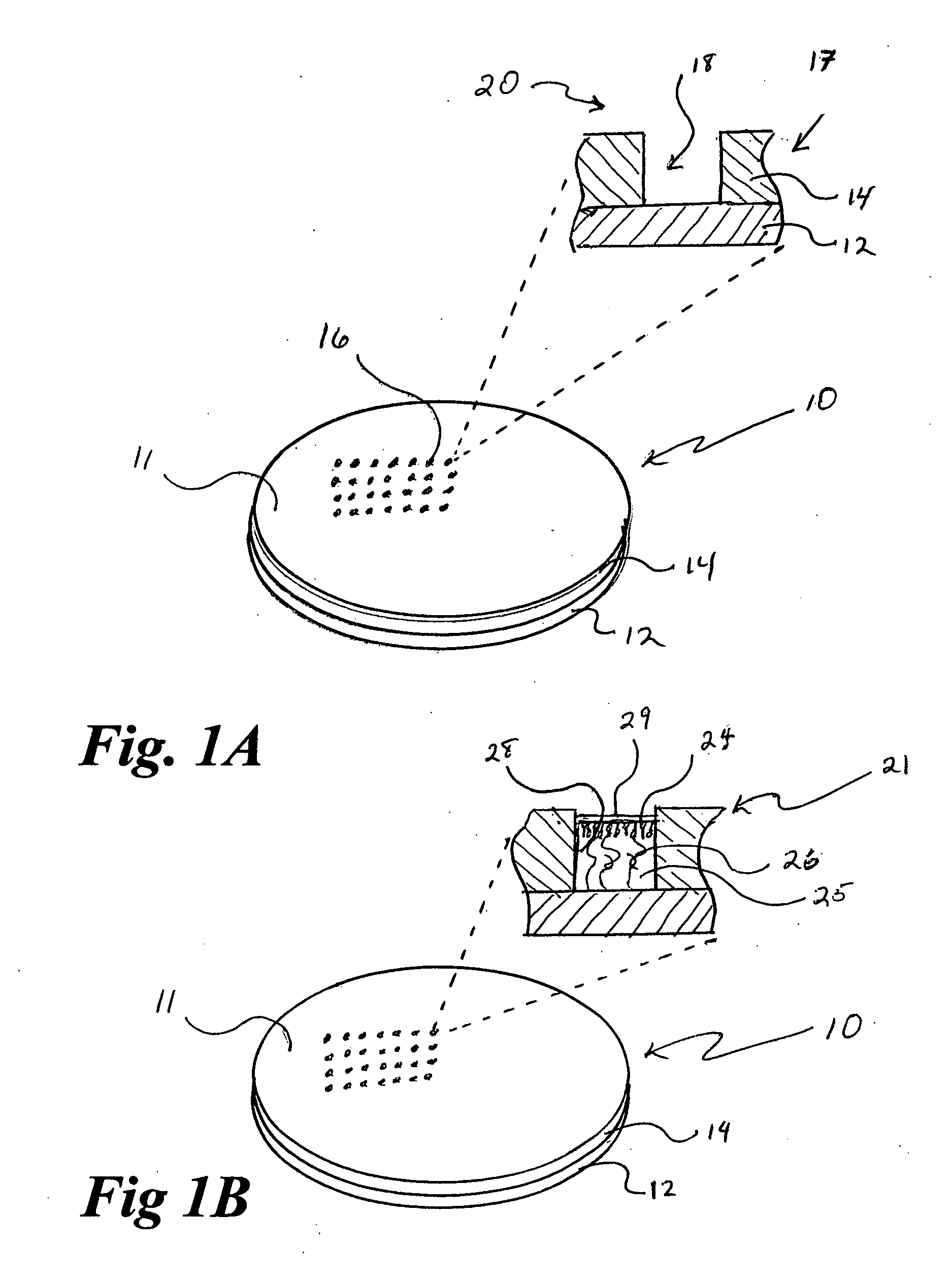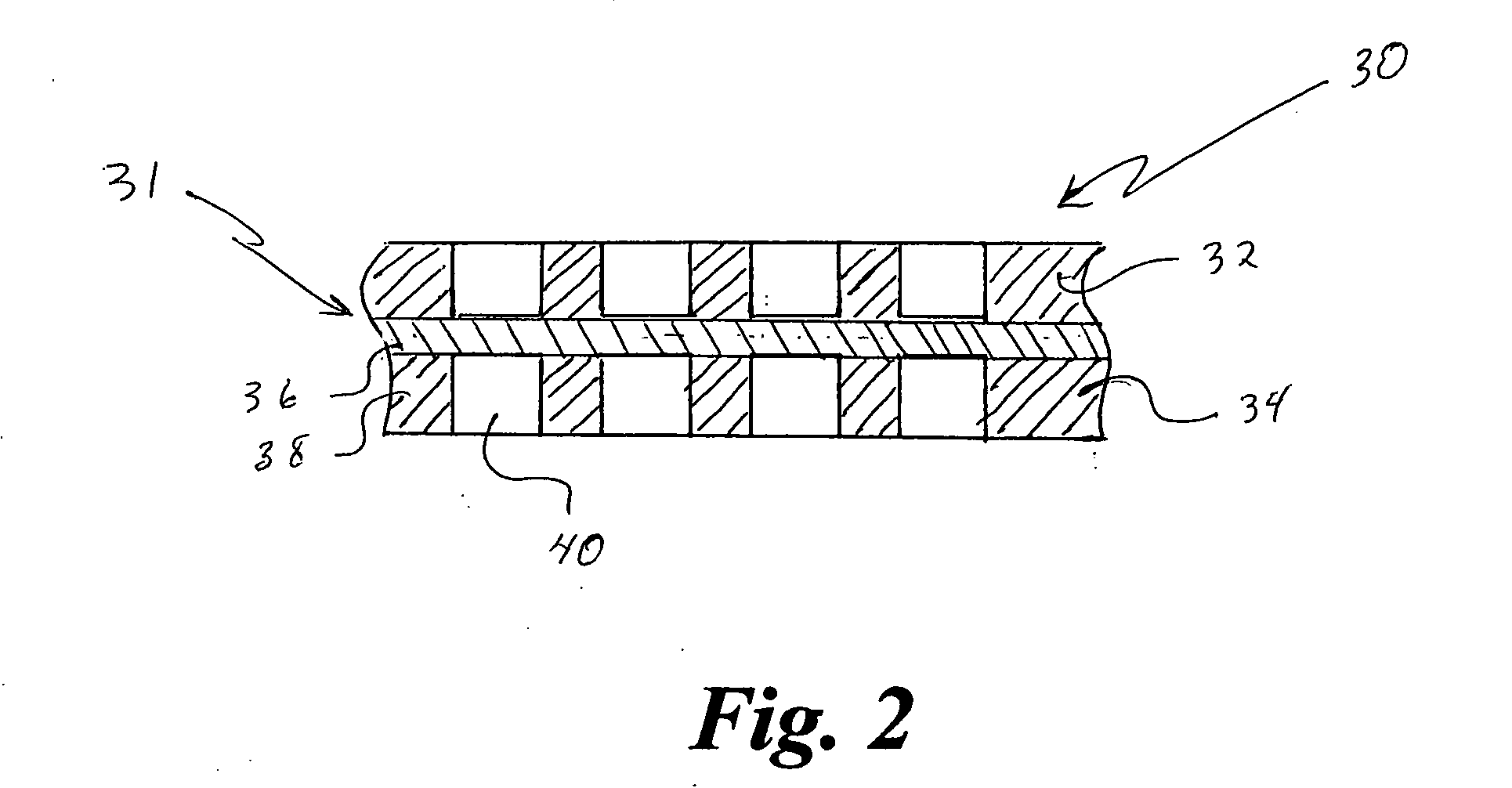Porous biosensing device
a biosensor and porous technology, applied in the field of porous biosensors, can solve the problems of major challenges in the sampling and analysis of analytes in complex biological environments, and achieve the effects of improving one or more of the sensitivity, response time and stability of the sensors, enhancing the sensitivity and response time of the sensors, and enhancing the stability of molecular receptors, catalysts, and cells
- Summary
- Abstract
- Description
- Claims
- Application Information
AI Technical Summary
Benefits of technology
Problems solved by technology
Method used
Image
Examples
example 1
Preparation of a Nanoporous Biosensor
[0076] A nanoporous biosensor device for use in the present invention can be prepared according to the following procedure. A wafer of γ-alumina sold under the trade name Anopore by Whatmann was initially coated using an epoxy resin (SU-8) to prepare the microreactors in six processing steps: spin coat, soft bake, expose, post expose bake, develop, and hard back. To obtain maximum process reliability, residual materials were removed from the nanoporous membranes using an ozone gas (Jetlight Co., Irvine, Calif.) that is capable of rapidly permeating the membrane. Before coating, the nanoporous membranes were baked at 90° C. for 15 minutes to ensure all residual moisture was removed. The membranes were then taped to a polymer coated paper template and placed on the vacuum chuck of the spin coater (Headway Research Inc, Garland, Tex. The polymer coated paper provides an impervious layer that prevents the photoresist from being drawn through the por...
example 2
Detection of Horseradish Peroxidase
[0082] The asymmetric biochemical reactions were demonstrated in the nanoporous substrate devices using the horseradish peroxidase (HRP) enzyme as a model catalyst according to known procedures. Peroxidases are a class of enzymes known to decompose two molecules of hydrogen peroxide into water through a superoxide ion pathway. HRP has been used as an immunohistochemical label as its specificity for the second molecule of hydrogen peroxide is low and other electron donors can be substituted. This allows HRP to be used as a catalyst for chemilluminescent and colorimetric substrates. In this work, the calorimetric reaction shown in Scheme 1 was used to detect the presence of the enzyme (see below). In this reaction, the 4-chloro-1-naphtol (4-CN) and N,N′-diethyl phenylenediamine dihydrochloride (DEPDA) react to form a water insoluble product that has a deep blue color.
[0083] In the asymmetric assay, the back of the membrane device was first exposed...
example 3
Biosensor Preparation
[0086] The following demonstrates a microfabricated biosensor can be used for high throughput screening of membrane protein functions using a micro-fluidity device inkjet arrayer. The membrane protein gramicidin was selected because its function has been extensively studied. Gramicidin is a hydrophobic protein consisting of 15 amino acids in a sequence of Val-Gly-Ala-Leu-Ala-Val-Val-Val-Trp-Leu-Trp-Leu-Trp-Leu-Trp. Gramicidin acts as a channel former through a bolalipid membrane. Two gramicidin molecules, each in a β-helix structure, join at their N-formyl terminus to generate a 30 residue peptide that extends across the lipid bilayer. Numerous studies have indicated that the gramicidin dimer has an outer and inner diameter of about 15 angstroms and 5 angstroms, respectively. The hydrophobic side chains are all located inside of the β-helix and the hydrophilic backbone carbonyls extend out of the helix and into the surrounding lipid bilayer.
[0087] Preparation ...
PUM
| Property | Measurement | Unit |
|---|---|---|
| Diameter | aaaaa | aaaaa |
| Volume | aaaaa | aaaaa |
| Volume | aaaaa | aaaaa |
Abstract
Description
Claims
Application Information
 Login to View More
Login to View More - R&D
- Intellectual Property
- Life Sciences
- Materials
- Tech Scout
- Unparalleled Data Quality
- Higher Quality Content
- 60% Fewer Hallucinations
Browse by: Latest US Patents, China's latest patents, Technical Efficacy Thesaurus, Application Domain, Technology Topic, Popular Technical Reports.
© 2025 PatSnap. All rights reserved.Legal|Privacy policy|Modern Slavery Act Transparency Statement|Sitemap|About US| Contact US: help@patsnap.com



